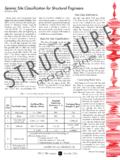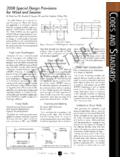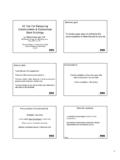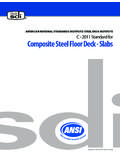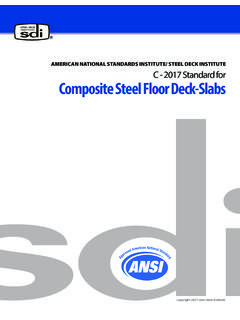Transcription of Antiquated Structural Systems Series
1 Aids for the Structural engineer s toolboxEnginEEr s notEbookSTRUCTURE magazineJune 2009 STRUCTURE magazine12 For this Series of articles, Antiquated has been defined as meaning outmoded or discarded for reasons of age. In reality, however, most of the Systems that have been discussed are no longer in use simply because they have been replaced by more innovative or more economical methods of construction. This article, however, deals with a meth-od of construction that is still very much in use today. Nevertheless, the historic, original construction practices described in this article may still be encountered in existing structures. Therefore, the pri-mary purpose of this Series of articles will be fulfilled: to compile and disseminate a resource of information to enable struc-tural engineers to share their knowledge of existing Structural Systems that may no longer be in use, but are capable of being adapted or reanalyzed for safe reuse in the marketplace of today and the Web Steel JoistsHistoryThe author would first like to thank the Steel Joist Institute (SJI) for providing much of the material that was used in the development of this article.
2 In fact, a brief history of open web joists is provided in the Catalog of Standard Specifications and Load Tables for Steel Joists and Joist Girders, published by SJI. A brief summary of this history is as follows: 1923 The first Warren type, open web truss/joist is manufactured using continuous round bars for the top and bottom chords, with a continuous bent round bar used for the web members. 1928 First standard specifications adopted after the formation of SJI. This initial type of open web steel joists was later identified as the First load table published. 1953 Introduction of the longspan or L- Series joists for spans up to 96 feet with depths of up to 48 inches, which were jointly approved by AISC. 1959 Introduction of the S- Series joists, which replaced the SJ- Series joists. The allowable tensile strength was increased from 18 ksi to 20 ksi, and joist depths and spans were increased to 24 inches and 48 feet, Steel Products Co.
3 , Inc Ashland City, Tennessee); Vescom Structural Systems , Inc. Westbury, New York; Ridgeway Joists (manufactured by Continental Steel Ltd. Coquitlam, British Columbia); Northwest Joist Limited (a Division of Brittain Steel Limited New Westminster, British Columbia); Cadmus Long Span and Joist Corporation (affiliated with Alexandria Iron Works, Inc. Alexandria, Virginia); T-Chord Longspan Joists (manufactured by the Haven Busch Company Grandville and Grand Rapids, Michigan); and the Macomber Steel Company Canton, Ohio. Table 1 (please see online version; article end note provides web address) provides a summary description of the joists produced by these addition, some manufacturers, prior to becoming SJI members, produced pro- ducts other than the historical stan-dard SJI joist Series . Some of these manufacturers include: Truscon Steel Company Youngstown, Ohio; Macmar and Kalmantruss joists (manufactured by Kalman Steel Corporation, a Subsidiary of Bethlehem Steel Company Bethlehem, Pennsylvania); and Gabriel Steel Company Detroit, Michigan.
4 Table 2 (please see online version; artcile end note provides web address) provides a summary description of the joists produced by these manufacturers. In addition to the information provided in Table 2, it should be noted that Bethlehem Steel Company also produced cold formed joists with hat channel sections for the chord members, and Gabriel Steel Company also produced unique V-shaped top chord and single round bar bottom chord manufacturers not included in Tables 1 and 2 include: Berger Steel Company (double V-shaped chord mem-bers); Armco Steel (cold formed hat channel chord members); Raychord Corporation (cold formed hat channel and U-shaped chord members); Republic Steel (cold formed hat channel chord members); and USS AmBridge (cold formed U-shaped chord members). Antiquated Structural Systems SeriesPart 9a Open Web Steel JoistsBy D. Matthew Stuart, , , F.
5 ASCE, SECB 1961 Introduction of the J- Series joists, which replaced the S- Series joists. The allowable tensile strength was increased from 20 ksi to 22 ksi. Introduction of the LA- Series joists to replace the L- Series joists, which included an allowable tensile strength increase from 20 ksi to 22 ksi. Introduc-tion of the H- Series joists, which provided an allowable tensile strength of 30 ksi. 1962 Introduction of the LH- Series joists, which provided yield strengths between 36 ksi and 50 ksi. 1965 Development of a single specifica-tion for the J- and H- Series joists by SJI and AISC. 1966 Introduction of the LJ- Series joists, which replaced the LA- Series joist. In addition, a single specification was developed for the LJ- and LH- Series joists. 1970 Introduction of the DLH- and DLJ- Series joists, which included depths up to 72 inches and spans up to 144 feet. 1978 Introduction of Joist Girders, including standard specifications and weight tables.
6 1986 Introduction of the K- Series joists, which replaced the H- Series joists. 1994 Introduction of the KCS joists, which provided a constant moment and shear capacity envelope across the entire length of the also recently published 80 Years of Open Web Steel Joist Construction. This publication includes a complete chrono-logical listing of the standard specifica-tions and load tables for all of the steel joists, and weight tables for the Joist Girders, previously made available by SJI over the time period from 1928 to 2008. This manual can be an invaluable tool for an engineer involved in the analysis of existing buildings constructed with open web steel addition, there were also a number of joists produced by manufacturers that were either never members of SJI or joined it later. Some of these manufacturers in-clude: Ashland Steel Joists (manufactured by S T R U C T U R E magazineCopyrightJune 2009 STRUCTURE magazineJune 200913D.)
7 Matthew Stuart, , , F. ASCE, SECB is licensed in 20 states. Matt currently works as a Senior Project Manager at the main office of CMX located in New Jersey, and also serves as Adjunct Professor for the Masters of Structural Engineering Program at Lehigh University, Bethlehem, PA. Mr. Stuart may be contacted at for Part 9b in an upcoming Material 80 Years of Open Web Steel Joist Construction; A Compilation of Specifications and Load Tables Since 1928; Steel Joist Institute; Myrtle Beach, South Carolina (2009).Catalog of Standard Specifications, Load Tables and Weight Tables for Steel Joists and Joist Girders; 42nd Edition; Steel Joist Institute; Myrtle Beach, South Carolina (2007).Miscellaneous Steel Joist and Joist Girder Specifications and Load Tables; SJI Archives; Steel Joist Institute, Technology, Engineering, and Education Center; Myrtle Beach, South CarolinaAnother ResourceRobert Higgins, , maintains a website that provides civil and Structural engineering information in the following categories: Out-of-print material that may be useful when working on existing facilities.
8 Older, usually conservative methods for solving technical problems. Public domain documents that have limited summary, this is content that is difficult to find anywhere else. To access it, visit 1 online version web address: 2 online version web address: T R U C T U R E magazineCopyrightTable 1: Unique Open Web Joists (Load Tables may be available from SJI)SystemFigureDescriptionYield StrengthDepth (inches) Span (feet)ChordsWebsNotesAshland 1HS- Series Joists50 ksi8 to 248 to 48 Double anglesRound barsN/ALS- Series Joists50 ksiUnknown64 maximumUnknownUnknownCadmus51952 Structural T Longspan & Standard JoistsSee Note 610 to 5412 -6 to 108 Split TAngles6, 7 Haven Busch61952 to 1962 T-Chord Longspan JoistsSee Note 918 to 8825 to 175 Split TAngles8, 9 Macomber7 Purlin or Steel JoistUnknown8 to 1610 to 26 See Note 10 Round bars108 Massillon Steel JoistUnknown8 to 164 to 31 Round barsRound bars9 Canton Steel JoistUnknown8 to 16 UnknownDouble anglesRound bars10 Buffalo Steel JoistUnknown8 to 16 UnknownSee Note 11 Round bars11N/ASpecial JoistsUnknown12 to 208 to 40 UnknownUnknown11 Residence JoistUnknown6 to 106 to 20 See Note 12 Round bars1212 Standard Longspan JoistSee Note 1418 to 4024 to 72 Double anglesAngles & bars13, 14N/AIntermediate LongspanSee Note 1418 to 2220 to 44 See Note 10 Round bars10.
9 14131955 New YorkerUnknown8 to 247 to 48V shaped platesRound bars14V or Double V Bar JoistUnknown8 to 224 to 44V shaped platesRound barsN/AV-GirdersUnknown18 to 4813 to 96V shaped platesRound bars15V-PurlinUnknown8 to 608 to 120V shaped platesSee Note 151516 AllspanUnknown8 to 768 to 152 V & Double V shaped platesSee Note 1515N/AV-Lok PurlinUnknown8 to 368 to 72V & Double V shaped platesRound bars or round pipes16, 1717V-Lok GirderUnknown12 to 4015 to 50 See Note 18 Round bars or Angles16, 1818V-BeamUnknown8 to 288 to 56 See note 19 Round bars19 Northwest4 Series 1, 2, 3 & 4 JoistsSee Note 512 to 7212 to 80 V shaped platesSquare bars & round pipes4, 5 Ridgeway3 Open Web JoistsSee Note 312 to 47 16 to 59 V shaped platesSquare bars & round pipes3 Vescom2 Composite Floor Joists36 & 50 ksi8 to 4020 to 48 Double anglesRound bars1N/AComposite Truss Girders36 & 50 ksi16 to 4020 to 50 Double anglesAngles2 Antiquated Structural Systems Series - Table 1 Part 9a Open Web Steel JoistsBy D.
10 Matthew Stuart, , , F. ASCE, SECBSTRUCTURE magazine June 2009 Antiquated Systems Series - Part #9a - Table 1S T R U C T U R E magazineCopyrightNotes:1. Top chord included deformed, extended vertical leg of one angle for composite action with surrounding concrete Top chord included deformed, extended vertical plate in addition to double angles for composite action with surrounding concrete Web allowable stress: 36 ksi (bars) & 50 ksi (pipes); Chord allowable stress: 54 Joist designs over 80 feet spans were available upon Web allowable stress: 33 & 44 ksi (bars), 50 ksi (pipes); Chord allowable stress: 55 Allowable compressive stress for top chord or web members = 15 ksi. Allowable combined compressive stress at top chord panel points and allowable tensile stress = 18 Chord tees cut from standard wide flange or junior Available as parallel chord, single or double sloped top chord or hipped end Allowable combined compressive stress at mid-panel chord and web = 15 ksi (1952); 20 ksi (1956).


